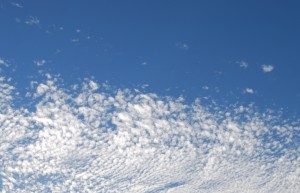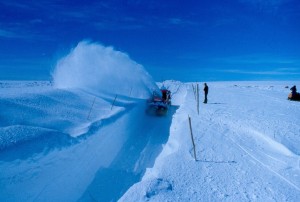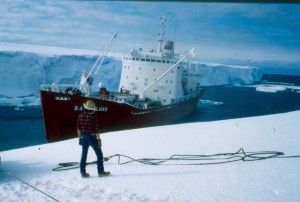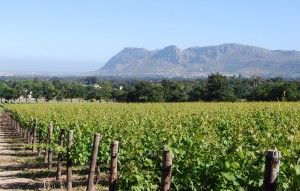CHAPTER < FOUR - MARGINS OF SURVIVAL
“Ignorance is the worst of evils.” Goethe
The Earth’s natural systems interrelate in intricate and complex ways to provide the conditions suitable for life. They did so before life began and they will probably do so if and when life eventually disappears from this planet. The magnetosphere, atmosphere, hydrosphere, lithosphere and biosphere exist not in isolation of one another, but in a synchronicity of processes that impact one on the other.
 A cause in one of Earth’s living systems produces an effect in another. For instance when there are few clouds covering the Earth, more sunlight is received and the world gets hotter. Then biological activity on land and in the ocean speeds up which produces more cloud cover. This in turn reflects sunlight away, cooling the globe. When there is thick cloud cover, biological activity is reduced which diminishes cloud cover, and the Earth again warms up. In these and other ways, feedback cycles have maintained an equilibrium that has kept the Earth habitable for billions of years. But the margins that govern the Earth’s habitability are smaller than we might think.
A cause in one of Earth’s living systems produces an effect in another. For instance when there are few clouds covering the Earth, more sunlight is received and the world gets hotter. Then biological activity on land and in the ocean speeds up which produces more cloud cover. This in turn reflects sunlight away, cooling the globe. When there is thick cloud cover, biological activity is reduced which diminishes cloud cover, and the Earth again warms up. In these and other ways, feedback cycles have maintained an equilibrium that has kept the Earth habitable for billions of years. But the margins that govern the Earth’s habitability are smaller than we might think.
The difference between a warm temperate interglacial such as we are living in right now and an Ice Age is only about three degrees centigrade. And an average of just nine degrees centigrade separates the mean temperature of today from the very coldest points of both the last Ice Age and the penultimate Ice Age. These are small margins between a world, which, although troubled, is still subject to the laws of civilisation as we know them, and a frozen world in which civilisation could disappear under a blanket of ice and snow. Contrary to what we might believe, an Ice Age, far from building up over a protracted period of time, could develop within the space of just a few short, bitterly cold winters.
If the right conditions occurred on Earth, this could be a reality within our lifetime. For example if massive volcanic activity on a scale greater than the eruption which blew Krakatoa Island to bits and spewed an ash plume kilometres high into the sky, were to occur on Earth at this time, the resultant atmospheric shield of volcanic dust would block out the Sun’s energy for the duration it took for the dust to clear out of the atmosphere. Alternatively, if there was a rapid fluctuation in the Sun’s radiation, either decreasing solar energy output by the sudden cessation of sunspot activity or increasing the amount of solar energy received from the Sun, thereby causing a thick reflective layer of cloud cover to form around the Earth, temperatures would plummet, bringing on freezing conditions.
 A nuclear winter would have a similarly devastating effect. In this frozen scenario, cities would become paralysed. Traffic, railway and air transport systems would fail, stranding people in their homes. Communication systems would also fail. Food and fuel supplies would quickly diminish and then run out completely. Hydroelectric power stations would become non-functioning as water supplies froze, and in a desperate attempt to warm their homes, people would resort to chopping down any wooden structures, telephone poles or trees that they could find. Law and order would break down and anarchy would rule as people fought each other for the last few remaining resources needed to survive. On a global scale this could result in the breakdown of civilisation, as we know it.
A nuclear winter would have a similarly devastating effect. In this frozen scenario, cities would become paralysed. Traffic, railway and air transport systems would fail, stranding people in their homes. Communication systems would also fail. Food and fuel supplies would quickly diminish and then run out completely. Hydroelectric power stations would become non-functioning as water supplies froze, and in a desperate attempt to warm their homes, people would resort to chopping down any wooden structures, telephone poles or trees that they could find. Law and order would break down and anarchy would rule as people fought each other for the last few remaining resources needed to survive. On a global scale this could result in the breakdown of civilisation, as we know it.
Hot As Hell
On the opposite side of the temperature spectrum a cumulative increase of three degrees centigrade would have just as dramatic an effect on the Earth’s systems. But this scenario, far from being a theoretical hypothesis as in the example above, could well become a global reality in our lifetime as temperatures are already on the increase. Evidence of this is seen in many places around the globe.
Glaciers as far north as Alaska are melting. According to the World Glacier Monitoring Service, glaciers all over the world are shrinking faster than they are growing, with huge losses of mountain glacier mass being predicted in the future. Arctic sea ice has significantly thinned and shrunk. Mount Fuji, Japan’s iconic mountain, is losing its distinctive snow-cap progressively each year as winter snows fail to appear. And tests conducted over an extensive region of Northern Alaska have shown that the permafrost is being affected by a distinct warming trend.
In the Southern Hemisphere there has been a temperature increase of two-and-a-half degrees centigrade over the past 50 years, which is a rate five times faster than the rest of the Earth. This is believed to have led to fluctuations in the populations of Southern Ocean birds such as the rock hopper penguin of Campbell Island, which has declined by about 94 per cent.
 The Antarctic icecap, oldest, coldest and largest icecap on the planet has also shown signs of shrinking in response to warmer temperatures – records kept by whaling vessels that operated in the Southern Ocean around Antarctica over the 20 years between the mid 1950s and 1970s indicate that the sea ice that surrounds the frozen continent may have declined by as much as 25 per cent during that time.
The Antarctic icecap, oldest, coldest and largest icecap on the planet has also shown signs of shrinking in response to warmer temperatures – records kept by whaling vessels that operated in the Southern Ocean around Antarctica over the 20 years between the mid 1950s and 1970s indicate that the sea ice that surrounds the frozen continent may have declined by as much as 25 per cent during that time.
Dramatic events like the collapse of the huge Larsen A and B ice sheets in 1996 and 2002 respectively, foretell of a warming region; as does the Intergovernmental Panel on Climate Change (IPCC) Fifth Assessment Report’s documentation of an average ice rate loss from the Antarctic Ice Sheet of 147 Gigatonnes per year over the period 2002 to 2011, which is a considerable increase from the average of 30 Gigatonnes of ice lost per year during the preceding decade.
There is evidence that glaciers along the Antarctic Peninsula and the floating West Antarctic ice sheet are retreating. This ice sheet, which is the size of India, is considered to be unstable and there is a possibility that it could break-up and melt if global warming becomes more pronounced. Should this occur, a sea level rise of almost 10 metres could be expected. This would effectively submerge many low-lying areas with resulting loss of arable land, homes, buildings and harbours.
Because a vast amount of energy is needed to thaw ice, glaciers and icecaps act as an energy barrier against the planet overheating. They also act as vast mirrors reflecting a significant proportion, as much as 70 per cent of the Sun’s heat back into space. To lose this essential safety valve could be disastrous in terms of global warming.
Of equal concern, global climatic changes have had a serious impact on the continent of Africa where more than 20 countries have experienced crippling droughts. Satellite images from outer space show a broad band of the northern part of the continent to be a brown desert belt. In these areas, people, livestock and wildlife have suffered terribly from a lack of rain, which has parched and denuded northern African landscapes into bleak, dusty sand bowls, leaving the dead as bleached skeletons on the cracked soil and the living as hungry phantoms.
 In southern Africa the picture is only marginally better, with areas such as the Western Cape in South Africa, an important stone fruit growing area which produces apricots, plums, nectarines and peaches, having become warmer and dryer over past years. This has impacted negatively on fruit production in the area with abnormal flower bud development, delayed foliation, fruit drop and poor fruit set affecting the canning, drying and fresh fruit consumption industries. It has also caused economic losses to the fruit producers.
In southern Africa the picture is only marginally better, with areas such as the Western Cape in South Africa, an important stone fruit growing area which produces apricots, plums, nectarines and peaches, having become warmer and dryer over past years. This has impacted negatively on fruit production in the area with abnormal flower bud development, delayed foliation, fruit drop and poor fruit set affecting the canning, drying and fresh fruit consumption industries. It has also caused economic losses to the fruit producers.
If this warming trend continues, and it is estimated that during this century the annual rainfall in the Western Cape will decrease by 15 to 25 per cent and the temperature will increase by two to six degrees centigrade, it could mean financial hardship for both commercial farmers and emerging small-scale farmers alike, as well as less sustainability of the deciduous fruit growing industry and related agri-business of the region. This would in turn create loss of jobs with attendant socio-economic problems. It would also affect foreign exchange earnings.
Until the new millennium, the decade of the 1990s was the warmest decade on record. However, within the first years of this century, the global mean temperature has risen markedly, taking temperatures to a level that could make this the warmest period of the past 100 000 years, or since the most recent Ice Age began…